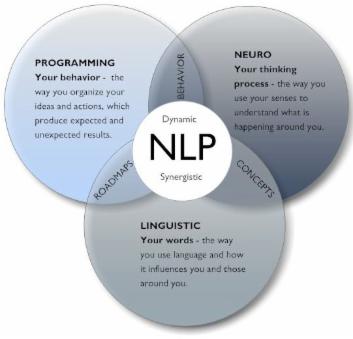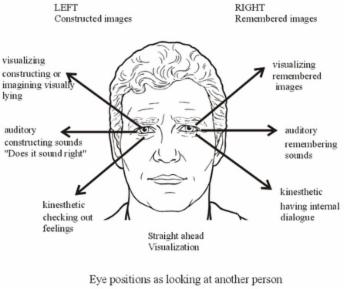 NLP
NLP Neuro Linguistics Programming
Neuro-Linguistics Programming is the Secret Language of the Mind.
It is the “running programs” of our behavior as well as a method by which we
can “language” with the programs in order to affect a change in our lives and
in the lives of others. In short, NLP is a Model of Behavior developed through
the awareness of personality and communication to consistently achieve a
desired outcome.
It is the MODEL OF COMMUNICATION AND PERSONALITY.
A brief history:
NLP was initially developed by John Grinder and Richard Bandler in the mid-1970s. Grinder was a professor of linguistics at the University of California and served in the US Special Forces, and Bandler was one of his star pupils. Their interest lay in how language could be used to influence people, and what created excellent performance over less than excellent performance. As a result of their studies, they developed what is now known as NLP. Since then, NLP has been used in almost all forms of human endeavour, including the workplace, education, sport, relationships, health, coaching, consulting and therapy. It has developed to such an extent that you can now do a master’s degree or PhD in NLP.
The basics of NLP:
NLP is about how people can be more successful, however they personally define success. Bandler and Grinder identified that people who were successful seemed to act (whether consciously or not) from a certain set of beliefs and attitudes.

The Presuppositions of NLP
1. Behind every behavior there is a positive intention.
2. The map is not the territory.
3. Anything can be accomplished when the task is broken down into small enough chunks.
4. There is no such thing as failure, only feedback.
5. People already have all the resources they need.
6. Every behavior is useful in some context.
7. If one person can do something, other people can learn from that person's success.
8. The messenger never rests until the message is delivered.
9. The meaning of your communication is the response you get.
10. Communication is redundant.
11. Choice is better than no choice.
12. People always make the best choice available to them at the time.
13. If what you are doing isn't working, do anything else.

In the process of creating Neuro Linguistic Programming, NLP discovered that by looking at someone else’s eyes as they move, you could tell HOW they think. Not what they think, but HOW they think. You can tell what they’re doing inside.

Based on initial observations in NLP, when people look up, they’re visualizing. When they look horizontally to the left and right, they’re either remembering or constructing sounds. When they look downward and to our left, they’re accessing their feelings. And when they look downward and to our right, they’re talking to themselves (Auditory Digital). The chart above is for a “normally organized” right handed person.
Don Simmons is a certified NLP practitioner through the Association of Integrative Psychology